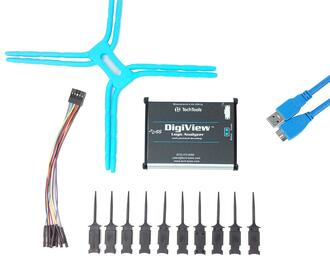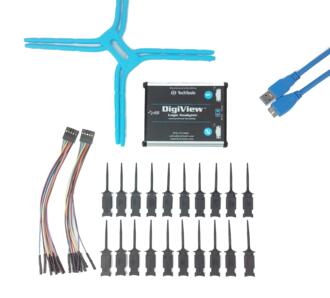DigiView™ Hybrid Controller
Most logic analyzers operate in a batch mode, where capture data is stored in local high-speed memory. This mode is very reliable but capture sizes are constrained by the very expensive local memory. Some recent devices operate in a 'Streaming' mode, where data is uploaded to the PC during capture to take advantage of its large existing memory. This mode can have long captures, but is susceptible to performance and reliability issues.
DigiViews have additional hardware and a Hybrid Storage Controller that improves on the best features of each mode, while eliminating their individual drawbacks. It also dynamically reconfigures the hardware to select the best mode...even in mid-capture, without loosing any capture data. This page explains how this is accomplished. Note that you do NOT have to read or understand this page to get the benefits. It is always enabled and requires no configuration. It 'just works.'
Operating Modes
Batch (Store-and-Forward)
The DV5 series (and all previous DigiViews) use a variation on this we call Store-and-Forward. The principle is the same; the buffer is dedicated to storing samples while capturing. Once capturing is complete, the data is forwarded to the PC for display and analysis.
- Guaranteed full data bandwidth operation at full sample rate
- Not dependant on PC, USB, or Windows performance
- Large buffer for long captures
- Hardware based compression greatly increases capture time.
- Dependable
- Never Over-runs
- Never misses a sample
- Never misses a trigger
- Never asks you to 'reduce sample rate' or 'try again'
Streaming
Streaming Characteristics
- Uses PC's memory to Extend Storage
- Hardware based compression reduces upload bandwidth, allowing for higher data bandwidth before the USB or PC are overrun. It also means we can keep the data in the PC's memory (rather than on disk), eliminating another bottleneck and source of bandwidth variations.
- Very Large FIFO makes the stream much more immune to high speed data bursts and/or PC 'hiccups' and latency.
- Hardware based trigger circuitry ensures that triggers are reliable. It also means that the PC does not have to process the data stream in real time, allowing us to keep our advanced trigger capabilities, and reduces dependency on the PC's performance.
- Since we do not emulate any of the analyzer's function in software, we do not need to process the real-time data stream at all. It is simply transferred to memory as quickly as it arrives; again, enhancing reliability.
NOTICE
DigiView's streaming mode is radically different than other 'Streaming' logic analyzers.
Other Streamers focus on reducing costs by reducing hardware - sometimes to little more than a USB bridge chip that samples and uploads its pin values at a fixed rate. The PC then attempts to process the stream of data and emulate the rest of the logic analyzer functionality in real-time. This approach greatly reduces the hardware cost and increases storage, but it compromises reliability and performance.
DigiView's Streaming Mode takes the opposite approach. Instead of eliminating hardware, we made full use of existing hardware, doubled the entire capture memory subsystem bandwidth, and added new hardware to support the new mode. This increased costs but added performance without sacrificing reliability.
DigiView™ Hybrid Controller Operation
All of this hardware support results in very reliable streaming at full sample rates and very high data rates. However, there is still a concern: Even though these data rates approach or even exceed the maximum data rates you would normally try to capture at our maximum sample rates, there are times when you have to work on the edge. Sampling at only 2 or 3 times the data rate results in high edge uncertainty and low fidelity waveforms, but sometimes you have no choice. Also, if you only have USB2 ports, your limits are much lower. In these extreme cases, you could still overrun the streaming mode.
We feel the capture should never fail or abort...no matter what. To meet those standards, we accommodate these edge cases by also including our traditional store-and-forward mode and an automatic fall-back mechanism.
DigiView's Hybrid Controller starts in streaming mode. If the long-term average data rate exceeds the streamable limit, the hardware predicts the over-run and seamlessly falls-back to store-and-forward mode without loosing any data. All trigger settings are still honored. If a trigger was not detected before the fallback, the hardware will continue looking for it, honoring the prefill setting.
See the 'Streamable Data Rate Chart' below for the approximate streaming data-rate limits.
- Guaranteed full data bandwidth operation at full sample rate
- Not dependant on PC, USB, or Windows performance
- Extensive hardware support ensures Extended storage in all but the most extreme cases
- All functionality implemented in real hardware
- User does not need to select mode; The Hybrid Controller auto-adapts
- Dependable
- Never Over-runs
- Never misses a sample
- Never misses a trigger
- Never says 'reduce sample rate'
- Never says 'try again'

- Data is Streamable if its data rate (averaged over millions of transitions) is less than the values shown.
- The data can far exceed these numbers for millions of transitions and still be streamable as long as the average rate is met.
- Faster Data Rates do NOT result in failure. They simply cause the hardware to seamlessly fall-back to Store-and-Forward mode. You still get a reliable, full functioning capture, just without the benefit of the full extended capture time.
- The sample RATE is always set to maximum and does not affect these numbers.
| Streamable Data Rates (Transitions/sec) | ||
| Mode | USB3 | USB2 |
| 4ch | 160M | 20M |
| 9ch | 160M | 12M |
| 18ch | 100M | 10M |
Need more information?
Browse the left-hand menu, or choose one of of these shortcuts:Ready to hunt down bugs?
Choose your debug partner.
DV509

500Msps@9ch
100M Transitions, > 1B samples
4M-18M Protocol Characters/Bytes
$599
DV518

250Msps@18ch
100M Transitions, > 1B samples
4M-18M Protocol Characters/Bytes
$749
All DigiViews include: • All available Protocol Plugins • USB and Data Cables • Full compliment of Micro-grabber clips • Plugin Developers' Kit
1 Try our interactive chart for more capture details.